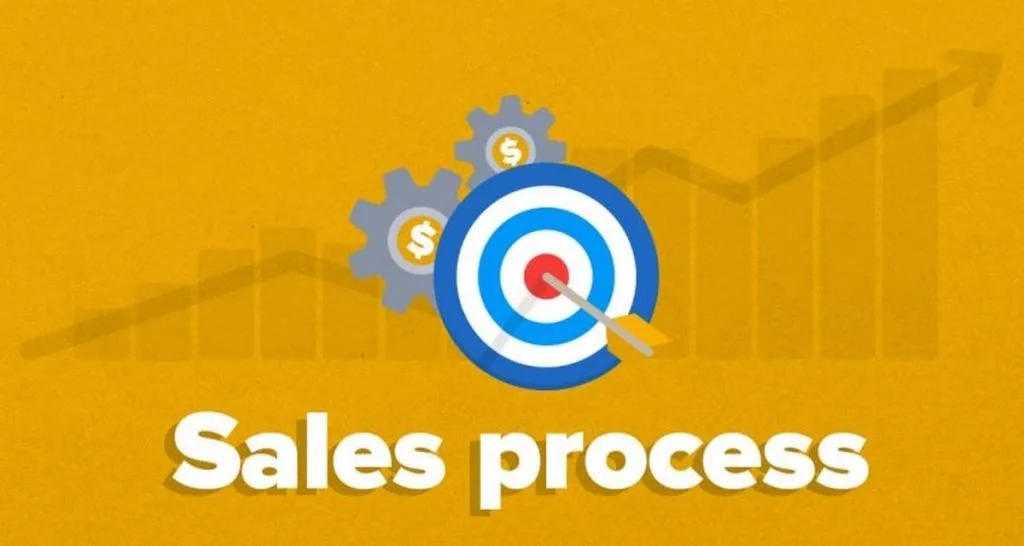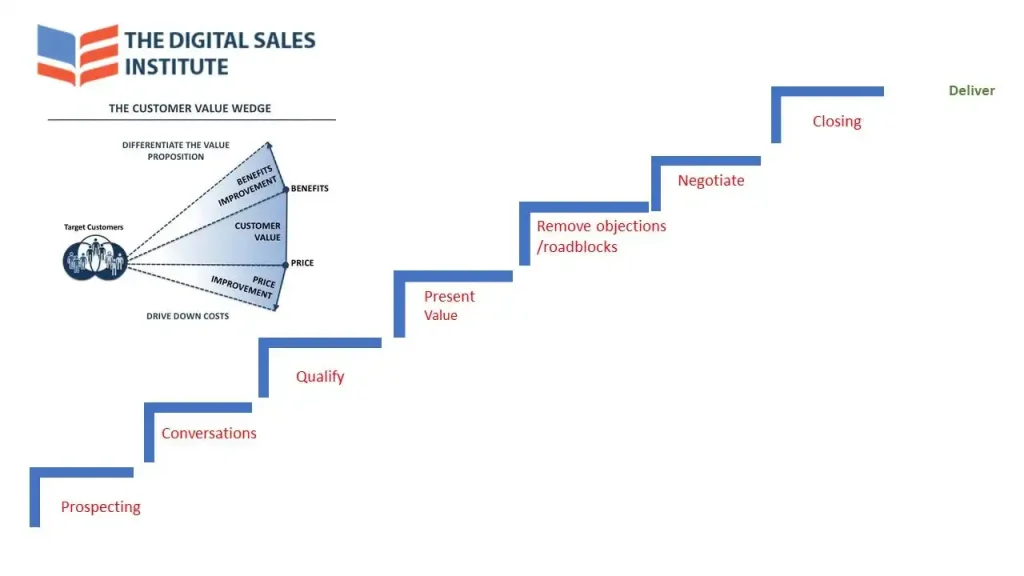Build A Sales Process in Eight Easy Steps
Build your process with these easy and quick-to-understand steps. Having a documented sales process is one of the biggest contributors to sales success. An effective sales process helps you track your opportunities, create a common language around the steps of the sale, and make accurate forecasts.
Different companies have different names and definitions for their sales stages. Depending on the size and complexity of the deal, sales processes can have between three and eight sales stages. But it doesn’t matter how many there are or what they’re called, as long as everyone agrees and understands each stage.
What Are the Main Sales Process Steps?
Regardless of whether you are new to sales or an experienced salesperson, the following easy-to-follow steps will guide you through a successful process that adds to your sales engagements. As what each company sells to whom is different, you should adjust or add steps as needed to accommodate your business, product, or prospect.

Product Knowledge
Today, the diversity and dynamics of customer needs and expectations require a salesperson to be an expert. This means knowing the company’s product or service, where it fits in the market, the value it brings, and the benefits of the product when compared to competitors’ products. Product knowledge shapes the mental attitude in preparation for engaging customers.
Your Ideal Prospect
To build a sales process, companies need to create a buyer persona that highlights demographic, behavioral, and interest-related information about their ideal prospect. If you don’t already have a buyer persona or ideal customer profile, spend time researching your target market.
Here are a few key questions to help your research:
Do I have any data on existing customers that can help me outline the ideal prospect?
What unique value does my product or service provide, and who has these needs?
What are the characteristics of prospects targeted by my competitors?
Where are my ideal prospects located, and how do they engage with businesses like mine?
Identify, Prospect and Lead Generation
Identifying and prospecting is the process of finding named contacts within an organization that are a good fit to open a sales conversation. This begins with research to collect more insights about potential needs or pain points. This entails visiting their web site for news, etc.; internet searches for announcements, PR, news, market trends, etc. You could use data tools like Apollo, LinkedIn, and ZoomInfo to gather more details or contact information. This data should be recorded in your CRM to streamline the prospecting process.
Who is the customer?
What is their organization and industry?
Who are the stakeholders?
Qualify Prospects
To qualify a prospect in your sales process, you are trying to find AWAF—Are We A Fit? Not all prospects are equal. Before you invest time in developing a relationship, you need to verify that your product is a good fit for the prospects you’ve identified. Sales methodologies require that a qualification call or a series of calls be enacted. The qualification call collects basic information about budget, authority, need, and timeline (BANT). As you build a sales process, BANT allows you to identify the prospects that are most likely to progress through each sale stage and make commitments.
Focus on the following key questions during your sales interactions:
- What does the prospect need, and does this need align with your product?
- Do they plan to make a product purchase soon? If so, when?
- How much do they have to spend on your product?
- Who has the authority to make the purchase?
- What are the customer’s plans and pain points?
- What opportunities have you identified?
- What are the next steps?
- Has the customer agreed to the next steps?
Discovery
Relevance is what is important for your customer. So now you seek to understand how relevant your offering is to their current position. It is a conversation to see if you and your client are a good fit to work together (note AWAT goes both ways).
Below are a couple of sample questions:
What pain points or problems do you have right now?
How have these problems affected your day-to-day work or life?
What’s preventing you from finding lasting solutions?
If you implemented solutions that didn’t work, why didn’t they work?
What would an ideal solution look like?
Once you have answers to the questions above, you can easily identify products that will solve prospect problems. If a prospect doesn’t identify a problem that can be solved with your product, remove them from your list. The output of this stage in the sales process, is that you and the prospect are in clear agreement on their business needs and technical requirements. The prospect confirms the value of the potential solution.
Before you leave this stage, you should have solid answers to the following:
- What is their current technical environment?
- What type of solutions do they have in place?
- What primary applications are they currently using?
- Who is the project champion or executive sponsor?
- Who is the power buyer?
- Have you identified other contacts on the decision-making committee and asked what their role is?
- Has the project champion admitted the need for your solution?
- Did the sponsor agree to evaluate your solution?
- Do you have some idea of the project timeline?
Validate
In this sales process stage, you present a compelling, crisp, differentiated concept with a credible and quantifiable return on investment. You have a detailed understanding of the prospect’s approval process, and they have agreed to continue on the buyer’s journey. You customize your presentation and write out any likely objections plus prepare responses that will overcome these objections. Remember, salespeople who have the sales skills at completing sales presentation tasks are likely to perform at a higher level. Learning sales presentation skills leads to improved job performance.
During the validation discussions, make sure you focus on solutions and outcomes, not on product features. Be open to objections and take the time to ask for additional details and context so you can understand the root of the problem. Lastly, suggest a timeline for next steps at the end of the presentation. This should include any follow-up calls and a proposed deadline for the sale to close.
Before you leave this stage, you should have answers to the following:
- How well do they understand your product/service and solution?
- Have the technical issues been discussed?
- Has the power buyer admitted to the business gap and outlined specific needs?
- What other solutions has the prospect researched, considered, or implemented?
- Has the competition been identified? What other options is the prospect considering?
- Can the buyer articulate the vision of the solution?
Your goal is to effectively handle any business and technical objections to gain prospect acceptance.
Closing
In this stage of the sales process, the prospect has agreed to the terms and conditions of the sale and has signed the contract. The opportunity is technically closed and booked in the system. But you still have some questions to answer to make sure all is well. Answer these right away and urge them to sign of any other elements by the date specified.
Before you leave this stage, you should have the following:
- Has an order been received and booked into the system?
- Have all contractual terms and conditions been agreed to?
- Is there a signed contract?
- Are the appropriate approval signatures in place?
- Has the partner issued a PO to your organization?
- Have you done everything to ensure this step is completed?
Closing Tactics
1. Closing is not some mysterious event. If you stay on top of your deals all the way through the sales process, the close will happen.
2. Stay focused on the skills you’ve learned in this book. They have each been designed to lead you to the close. Just follow them, and you will keep your eye on the prize.
3. Build a healthy sales funnel that includes a solid assortment of small, medium, and large-sized opportunities.
4. Be ambitious. Build a large sales funnel to allow for potential fallout and strive to exceed your numbers.
5. Follow your sales process. Understand what to expect at each stage so you will never be surprised.
6. Align with your prospect’s buying cycle. Position yourself well with decision makers and other influencers to ensure your deal is solid.
7. Listen to your prospect’s pain, remember it, and use it to create compelling events. Drop the ‘‘happy ears’’—they will get you in trouble.
8. Stay focused on the compelling event. Once you have this identified, use it to help your prospects realize the importance of having your solution in place by a certain time.
Nurture the Relationship and Upsell
Now it is time to build on the relationship and nurture your new customer. However, the sales process isn’t over yet. Satisfied customers provide a huge opportunity for referrals, introductions, cross-selling and upselling.
You’ve learned your sales skills, reviewed your funnel, and located your deal in the sales process. What’s left? The customer! Align Your Sales Process with the Prospect’s Buying Process
Understanding your prospect’s decision-making process—who’s involved, who the key stakeholders are, and who makes the final call—is critical to your sales success.

Best-practice salespeople manage their selling activities from a solid understanding of how their customers buy: not only buying patterns and habits, but also details related to the steps customers take in making the purchase decision. ‘‘Buyers, not salespeople, now control the flow of information, making them savvier than ever before. They have developed their own processes for assessing, selecting, and negotiating with vendors, and added a number of formal and informal decision makers to this multi-month or multi-quarter process, challenging traditional sales cycle and sale methodology thinking to embrace this new paradigm.’’ The customer’s buying process actually maps well to the six stages of the selling process we just reviewed:
1. Recognize business strategy
2. Define requirements
3. Evaluate alternatives
4. Select solution
5. Negotiate
6. Implement solution
Understanding where your customer is in their process will help you align solidly with their needs. Take the time to do it.
Common Sales Process Mistakes
To build a sales process that sticks, you need to avoid some of the common mistakes that derail the process. Always have a sales conversation plan and here are some tips on how to avoid pitfalls.
Poor Preparation
Good research is key to successful sales. When done correctly, it allows you to speak confidently about what you’re selling and what problems it solves. When done poorly prospects lose confidence in your product and business. Take the time to understand both what you’re selling and your target audience to be able to address unique problems and value propositions.
Being Unprepared For Objections
There are countless potential objections to a sale: cost, bad timing, insufficient need, lack of product functionality, and so on. These objections are often easy to anticipate. Unfortunately, many salespeople struggle to close sales due to common objections they don’t know how to overcome. The best solution is to map out all likely prospect objections to prepare empathetic and impactful responses across all parts of the sales process.
Build A Sales Process in Eight Easy Steps – Online sales training courses
Comments
Post a Comment